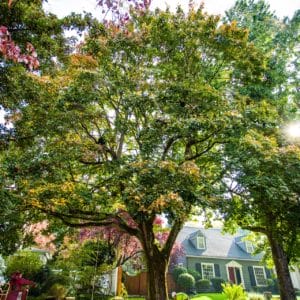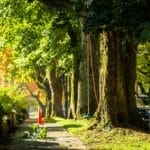 Deep root fertilization is the preferred and most effective method for fertilizing trees and shrubs. Through this process, a liquid, time-release fertilizer is pressure-injected in a grid pattern into the root zone of the tree or shrub. Well-nourished trees and shrubs have better resistance to disease, insect attack, and drought.
Deep root fertilization is the preferred and most effective method for fertilizing trees and shrubs. Through this process, a liquid, time-release fertilizer is pressure-injected in a grid pattern into the root zone of the tree or shrub. Well-nourished trees and shrubs have better resistance to disease, insect attack, and drought.
Deep root fertilizing can help keep your trees and shrubs healthy and promote luxurious foliage that adds beauty and value to your property. Liquid fertilizer is injected directly into the root zone area for maximum benefits. Its slow-release action won’t burn delicate feeding roots. Deep root fertilization can also help with problems of soil compaction. Liquid fertilizer injected into the root zone under pressure helps aerate the soil. It opens up air pockets, helping to provide much-needed oxygen to the root system. At Urban Forest Pro, we use a fertilizer with a 6-month time release.
 This method of fertilization is especially useful for trees and shrubs growing in lawns or having other vegetation such as ivy or other ground covers around them. The fertilizer is injected below the roots of the surface vegetation to provide maximum benefit to the slightly deeper roots of the trees and shrubs. Surface fertilization, such as typical lawn fertilization, usually does not provide a significant benefit to trees and shrubs. When fertilizer is applied to the surface, the thick, fibrous roots of lawns and ground covers utilize and hold the nutrients and do not allow them to infiltrate to the deeper sub-surface soil layer where the roots of the trees and shrubs reside. Micronutrients, such as iron and manganese, systemic insecticides, and Mycorrhizae can also be added to fertilizer to help treat other common tree and shrub problems.
This method of fertilization is especially useful for trees and shrubs growing in lawns or having other vegetation such as ivy or other ground covers around them. The fertilizer is injected below the roots of the surface vegetation to provide maximum benefit to the slightly deeper roots of the trees and shrubs. Surface fertilization, such as typical lawn fertilization, usually does not provide a significant benefit to trees and shrubs. When fertilizer is applied to the surface, the thick, fibrous roots of lawns and ground covers utilize and hold the nutrients and do not allow them to infiltrate to the deeper sub-surface soil layer where the roots of the trees and shrubs reside. Micronutrients, such as iron and manganese, systemic insecticides, and Mycorrhizae can also be added to fertilizer to help treat other common tree and shrub problems.
Frequently Asked Questions About Tree Health
My tree looks sick what can I do? Just like people, trees have the best chance of fighting off disease or recovering from an injury, if they have proper nutrition. The first step, which is something you can do yourself, is to fertilize the tree. The next step is to call an arborist for a consultation. You can call a consulting arborist who does not do the tree work to get an independent opinion about what is going on with the tree for a small fee or call a tree service for a free estimate where you will get recommendations on what should be done and prices for that.
If branches on your tree are dying back you need to act quickly to save your tree. Trees die from the tips of the branches back so dying branches are a serious symptom something is wrong (except when that is typical of the species). To check if a branch is dead when there are no leaves on the tree, look for leaves that dried up but did not fall of the tree and try breaking one of the twigs if it snaps, like the wood is dry, it is a dead branch.
There is construction going on near my trees should I be concerned? Absolutely, if someone is doing construction near your tree talk to the foreman to see what precautions are being taken to protect your tree. The general rule of thumb is that a tree needs a protected barrier of 1′ in a radius around the tree for every inch in diameter of the tree at breast height. If you are not satisfied insist that a consulting arborist is called to unsure that the trees are not endangered. A tree can be twice as big underground as they are above so precautions need to be taken.